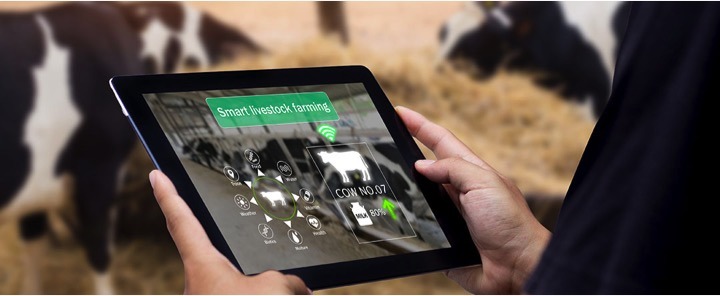The National Bureau of Animal Genetic Resources (NBAGR), Karnal has developed a software package entitled, ‘Information System on Animal Genetic Resources of India’ (AGRIS-IS). It is a database system that can store information on different breeds of domesticated animal and poultry, list of livestock farm, semen banks, breeding tracts and related literature.
The Veterinary Parasitology division of ICAR Research Complex for North Eastern Hill Region, Meghalaya has developed a computer software package to facilitate the diagnosis of oocyst, eggs, larvae of different parasites of livestock and human beings, so that a definite conclusion can be made in the diagnosis of parasitic diseases.
National Centre for Integrated Pest Management (NCIPM) has developed Nematode Management Information System (NMIS) software for identification and management of different types of nematodes. This is user-friendly software which includes the information about identification, symptoms with pictures, and management of each nematode.
Role of ICT in Dairy Sector
ICSs are more applicable and beneficial in dairy processing plants, feed mixing units, meat processing units. Computer-based information systems are being used to assist the management in speeding up data processing activities and maintaining quality control of milk products.
Important applications of ICTs are presented below:
ICT tools are efficiently used in on-line weighing and quality testing of milk. Computer-based systems enable prompt, accurate and immediate payment to the milk producers and minimize the malpractices and underpayment.
Widespread use of sensor network can improve the monitoring of dairy plant and generate valuable inputs for crisis management. For example, environmental censors to monitor temperature, video cameras/image sensor for security, plant operations and observing behaviour of staff, visitors, etc.
GPS is useful to trace vehicles during milk transportation, from collection centres to central dairy dockyard and marketing of dairy products to minimize malpractices on route. Artificial Neural Network (ANN) tools also have been used by researchers to solve problems related to dairy and food processing.
E-nose has many applications in sensory evaluation of quality of foods, detection of environmental toxins, carcinogens and pollutant, air quality as well as in medicine. It is useful in identifying adulterants, toxins, contaminants and aroma differences in food products. It also helps in assessing the quality acceptance and ageing process of stored food products.
E-tongue helps in continuous control on product quality in food industry. It is also used widely in quantitative analysis and recognition (identification, classification) of a very wide range of liquids, quality control and identification of the conformity to standards for different food stuffs-juices, coffee, beer, wine, spirit, etc. It also helps in continuous monitoring of test quality of food from raw material stage to final product.
Rotos are being used in many food processing activities because of their versatile features. They are used in high speed repetitive operations in modern day food processing and packaging where human operators begin to show onset of fatigue thereby increasing risk of metal errors causing quality or hygiene problem. They are also being used in precision curd slicing and ultrasonic cheese slicing, food packaging and stacking operations.
Simulation is a mathematical model used as a powerful tool in food processing applications for understanding the behaviour of complex interactive systems, predicting operation results, developing process control system or optimizing the performance of a system.
The functions of many automatic milk and food processing equipment are based on ICT enabled technologies such as determination of solid-not-fat (SNF) in milk. Application of ICTs in processing of food products reduces the manpower handling which helps to meet international hygienic and safety standards of the products.
Information Kiosks
A kiosk is a small shop, open at the front, where newspapers, sandwiches, soft drinks, etc. are sold. It is also synonymous to a public telephone box or booth. An information kiosk (or information booth) dispenses free information in the form of maps, pamphlets, and other literature, and/or advice offered by an attendant.
Generally, information kiosk means booth with telecommunication and ICT facility Information kiosk may store date locally, or retrieve it from a computer network. Information shops (Kiosks) are the places where computer-based information relating to better cultivation practices, value added information on market price, weather forecast, bus and railway time table are available.
Each kiosk is provided with a computer and modem with telephone dial-up to connect the date bases/agricultural portals. The farmer can take the assistance of the operator of the kiosk for nominal charges.
The concept of information kiosks is being discussed, debated and experimented in India at various places, Example:
Info village of the M.S. Swaminathan Research Foundation (MSSRF), e-choupals of Indian Tobacco Corporation (ICT), touch screen information kiosk of the Rajiv Gandhi College of Veterinary and Animal Sciences.
Social Media
Social media are the means of electronic communication over the Internet. They use special application software for interpersonal communication. Communication through social media can be done using computer or mobile phone. Greatest advantage is person to person communication with mass participation. Other advantages include cost effectiveness, location specific, problem oriented, user generated content, democratic, etc.
Social media has shaped the way people consume information, from only consumers of information to users who express opinions, share feedback and even create content. By 2021, the Internet users in India are set to double.
With over 420 million mobile Internet users in the country, it has brought power to people’s hands. The proliferation of smart phones has contributed to the rise of the phenomenon where users through devices can now participate from anywhere.
For example, Face book can be done through the mobile and computer, WhatsApp can be used only through mobile phone. The easy accessibility of social media through smart phone has made this new media useful for extension.
Many institutions and organisations have social media as their links such as Facebook, Twitter, YouTube, etc. Nowadays, WhatsApp has become an important social medium to communicate with peers and clients. But the communication being personal and within group not much communication is possible within cross groups.



























